

Algal Blooms in the Ocean - sea, oceans, effects, temperature, important, salt, types, plants, source, effect, marine, oxygen, human, Pacific. The ocean, that vast body of water covering 71 percent of the Earth's surface, is divided into four major basins: the Pacific, Atlantic, Indian, and Arctic Oceans.
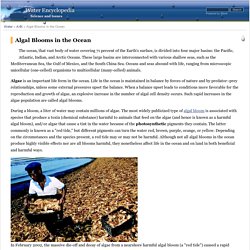
These large basins are interconnected with various shallow seas, such as the Mediterranean Sea, the Gulf of Mexico, and the South China Sea. Oceans and seas abound with life, ranging from microscopic unicellular (one-celled) organisms to multicellular (many-celled) animals. Algae is an important life form in the ocean. Life in the ocean is maintained in balance by forces of nature and by predator–prey relationships, unless some external pressures upset the balance. When a balance upset leads to conditions more favorable for the reproduction and growth of algae, an explosive increase in the number of algal cell density occurs. During a bloom, a liter of water may contain millions of algae. Requirements for a Bloom Temperature and salt concentration determine the density of water and how water moves (currents). Algal bloom. An algal bloom or marine bloom or water bloom is a rapid increase in the population of algae in an aquatic system.
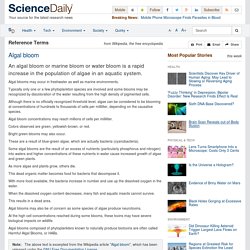
Algal blooms may occur in freshwater as well as marine environments. Typically only one or a few phytoplankton species are involved and some blooms may be recognized by discoloration of the water resulting from the high density of pigmented cells. Although there is no officially recognized threshold level, algae can be considered to be blooming at concentrations of hundreds to thousands of cells per milliliter, depending on the causative species. Algal bloom concentrations may reach millions of cells per milliliter. Colors observed are green, yellowish-brown, or red. Bright green blooms may also occur. These are a result of blue-green algae, which are actually bacteria (cyanobacteria).
As more algae and plants grow, others die. This dead organic matter becomes food for bacteria that decompose it. Harmful Algal Blooms Observing System. Harmful Algal Blooms. Ranging from microscopic, single-celled organisms to large seaweeds, algae are simple plants that form the base of food webs.
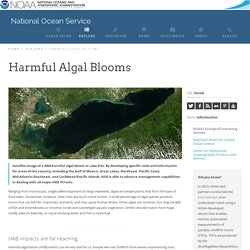
Sometimes, however, their roles are much more sinister. A small percentage of algal species produce toxins that can kill fish, mammals, and birds, and may cause human illness. Other algae are nontoxic, but clog the gills of fish and invertebrates or smother corals and submerged aquatic vegetation. Others discolor water, form huge, smelly piles on beaches, or cause drinking water and fish to taste bad. Harmful algal bloom (HAB) events can be very bad for us. Coastal HAB events have been estimated to result in economic impacts in the United States of at least $82 million each year. In December 2004, the Harmful Algal Bloom and Hypoxia Amendments Act of 2004 (Public Law 108-456) was signed into law. Although all coastal states experience harmful algal blooms, different organisms live in different places and cause different problems.
HABs and climate change. Ocean Acidification Intro - Revolution. Discover the threats, causes and impacts, and how you can help.
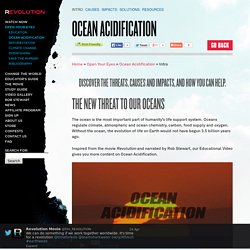
The New Threat to Our Oceans The ocean is the most important part of humanity’s life support system. Dead zone. Dead zones are low-oxygen, or hypoxic, areas in the world’s oceans and lakes.
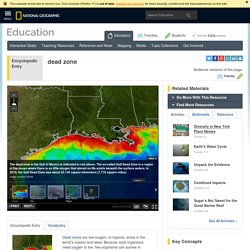
Because most organisms need oxygen to live, few organisms can survive in hypoxic conditions. That is why these areas are called dead zones. Dead zones occur because of a process called eutrophication, which happens when a body of water gets too many nutrients, such as phosphorus and nitrogen. At normal levels, these nutrients feed the growth of an organism called cyanobacteria, or blue-green algae. With too many nutrients, however, cyanobacteria grows out of control, which can be harmful. Understanding the eutrophication process provides the clearest picture of how and why dead zones develop. Risks to Oceans. There are three main ways that the ocean water quality is at risk.

They are: Litter in the oceans Did you know that the litter on land can end up in the oceans? Marine litter is hard to see because much of it floats under the surface of the water. The only place that we can really see marine litter is on the shorelines. How does marine litter hurt humans, ecosystems and wildlife? Water quality gets worse as litter releases poisons and chemicals. Marine litter can block plants from getting light. Photo: CCE-LTER The Great Pacific Garbage Patch In one part of the North Pacific Ocean, the ocean currents create a gyre (a huge slowly moving spiral of water). It’s hard to know how much garbage is in the gyre, but it’s probably millions of pounds. Learn about how you can prevent marine litter! Back to top Coral reefs at risk There are a number of things damaging precious coral reefs.
Fertilizer used on farms or home gardens washes into the oceans. Algae - KidRex. Green Algae. Harmful Algal Blooms.